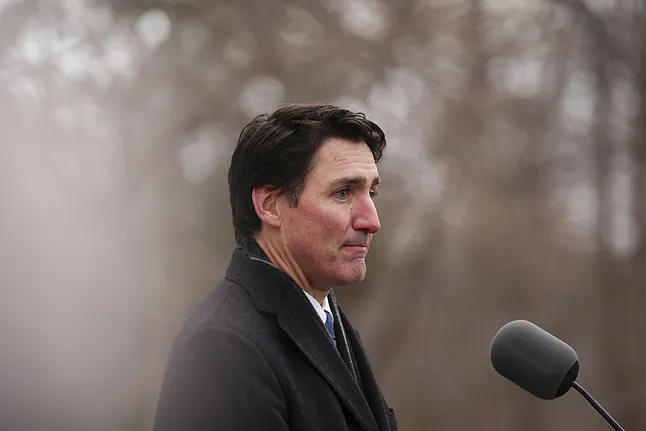After weeks of uncertainty and unrest within his ranks, Justin Trudeau announced his resignation on Monday as leader of the Liberal Party, a position he held since April 2013, and as Prime Minister of Canada, after over nine years in power. The decision comes amidst a growing lack of confidence within his party, the threat of a vote of no confidence from the opposition, and the likely defeat against the Conservative Party of Pierre Poilievre in the upcoming general elections scheduled for October, according to polls.
Trudeau's departure marks the end of a long chapter in Canada's recent history. The leader arrived in Ottawa in October 2015, bringing the Liberals back to power from the political wilderness. He would win at the polls on two more occasions, in 2019 and 2021, but each time with diminishing support, leaving him in an extremely weak position. Although he has stated that he will remain in power until a new Liberal leader is chosen, his party faces numerous questions: who will take over, how will they handle the imminent elections, and how will they navigate the economic turbulence in a scenario marked by the return of Donald Trump to the White House on January 20.
Trudeau's popularity plummeted in recent months, during which his government narrowly survived a series of no-confidence motions, and critics called for his resignation, amidst the country's cost of living crisis and fears about how Trump's threat to impose 25% tariffs on Canadian products would impact the national economy.
These resignation calls intensified in December following the unexpected resignation of Chrystia Freeland, Deputy Prime Minister, Minister of Finance, and Trudeau's right-hand woman, just hours before she was set to present her annual fiscal report. This was partly due to disagreements on how to handle the issue of potential tariffs.
In her resignation letter, Freeland criticized the Prime Minister's "political tricks," referring to the suspension of the VAT for two months and the $250 Canadian dollar bonuses (¤167.55) for most workers. The former minister stated that Canada "cannot afford" these policies, seen as pre-electoral handouts to win back some voters, especially when the country faces the serious threat of tariffs that the incoming Trump Administration could impose.
By the end of the year, several members of the Liberal coalition joined the resignation calls, leaving Trudeau with fewer and fewer options. The Atlantic, Ontario, and Quebec caucuses - three regions that account for 131 of the 153 Liberal seats in the House of Commons - indicated that most of their members no longer supported the Prime Minister leading the Liberal Party. Meanwhile, Conservative Party leader Pierre Poilievre threatened to table a vote of no confidence against the government when Parliament resumed sessions, initially scheduled for January 27.
Prior to the rumors of the Liberal leader's resignation on Monday, it was planned for the national Liberal Party caucus to meet this Wednesday for Trudeau to reveal his political future, but internal pressure accelerated this process.
Surveys also hit historic lows by the end of 2024. According to the Angus Reid Institute analysis, the Liberal Party barely has 16% support, while Trudeau's approval rating, which had hovered around 25%, dropped to 22%.
No. Trudeau explained in his address that the Governor General, Mary Simon, had accepted his request to prorogue Parliament, a mechanism that will halt all proceedings, including debates and votes, without dissolving it.
Although this is a routine parliamentary procedure, governments sometimes resort to it to buy time during a political crisis. This latest prorogation will freeze Parliament until March 24. Liberals are likely to try to appoint a new leader by that date.
How Will a New Leader of the Liberal Party Be Chosen?
It is not yet known exactly. Typically, leaders of Canadian federal parties are chosen over a period of four to five months, a process that includes a formal leadership convention.
During his national address on Monday, Trudeau stated that he would remain in office until "the party selects its next leader through a competitive and rigorous national process." Later, he revealed that this process had already begun on Sunday, after informing the Liberal Party President, Sachit Mehra, of his decision to resign.
"I am eager to see how the process unfolds in the coming months," Trudeau declared.
Who Are the Potential Candidates to Succeed Trudeau as Leader of the Liberal Party?
Traditionally, a politician who assumes the role of interim leader after the Prime Minister's resignation does not later run as a candidate to lead the party in Canada. This limits who could succeed Trudeau. However, several names are already being considered as potential contenders for the party's top position:
So, Will Early Elections Be Held?
Not necessarily. The resignation of a Prime Minister does not automatically lead to the fall of their government or the holding of early elections. For that to happen, a vote of no confidence in Parliament would be necessary, an eventuality that remains likely in Canada, even after Trudeau's successor is appointed.
The opposition parties, the Conservative Party, the Bloc Québécois, and the New Democratic Party (NDP), have expressed their intention to table a vote of no confidence upon Parliament's return. If the vote prevails, as is likely, early federal elections would be called.
In a statement, Pierre Poilievre stated that Trudeau's resignation "changes nothing," and his party will proceed with the vote of no confidence, as will NDP leader Jagmeet Singh, who in September ended his party's agreement to support the Liberal minority government, suggesting to Canadians not to support any Liberal leader. "The problem is not just Justin Trudeau. It's all the ministers who have been calling the shots," he concluded after the news broke.
